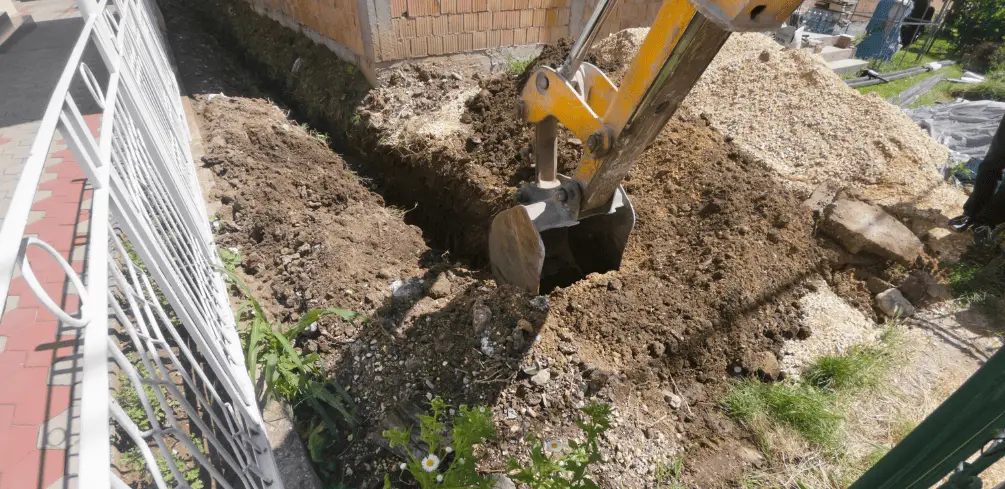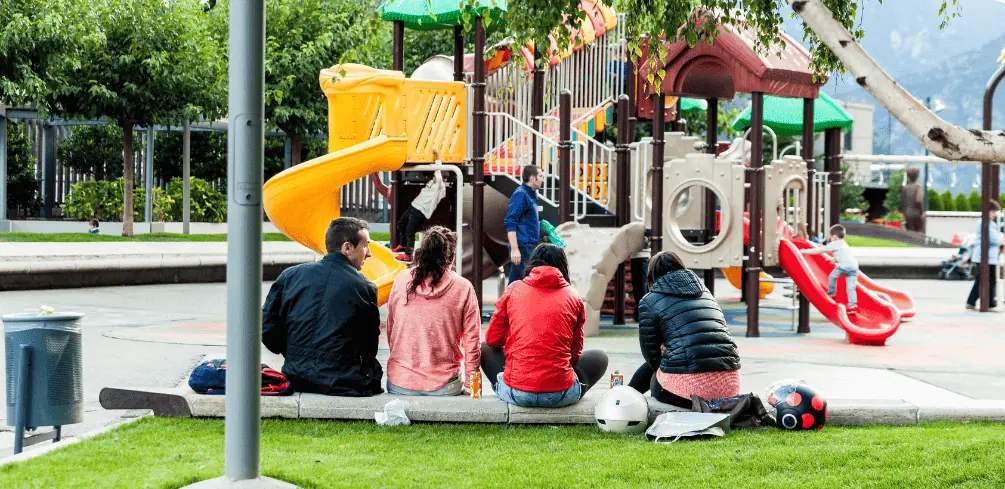Have you ever wondered just how far down you can dig in your own backyard?
Whether it’s out of curiosity, a desire to create the perfect underground hideout, or uncovering hidden treasures, there are certain factors to consider before embarking on such an excavation.
From understanding local regulations and potential hazards to analyzing soil composition and stability, it’s essential to be well-informed and prepared for what lies beneath your property.
So put on your hard hat, grab your shovel, and join us as we investigate exactly how deep you can go when digging in your backyard – all while keeping safety and practicality at the forefront.
Factors Affecting Excavation Depth

You’ll find that factors like soil stability, utility lines, and local regulations can really impact how deep you’re able to dig in your backyard. Excavation equipment plays a significant role in determining the depth achievable as well.
For instance, using heavy machinery might help you reach greater depths faster; however, it may also pose risks to the structural integrity of nearby buildings or your home.
Therefore, it’s crucial to assess these factors before starting any excavation project.
Depth limitations should also be considered to ensure minimal groundwater impact and maintain a safe working environment during excavation.
Soil stability is vital for preventing cave-ins and maintaining the structural integrity of the excavated area. Safety precautions should be taken into account to avoid accidents involving workers and damage to property while digging deeper into the ground.
Moreover, it’s essential to identify any utility lines present in your backyard – such as water pipes, gas lines, or electrical cables – as interfering with these can lead not only to costly repairs but also to potential hazards.
Navigating local regulations is another critical aspect when determining how far you can dig in your backyard.
Different municipalities have their own set of rules governing excavation projects on private properties; thus, consulting with local authorities will provide information on any legal restrictions or permit requirements specific to your location.
Additionally, some areas may have environmental protection laws that aim to preserve groundwater levels or safeguard against soil erosion – which could influence permissible excavation depths within your property boundaries.
By carefully considering all these factors upfront, you’ll be better equipped to make informed decisions about how deep you can safely and legally dig in your backyard without causing harm or violating regulations that might result in penalties down the line.
Understanding Local Regulations

Before grabbing that shovel, it’s crucial to familiarize yourself with local regulations – they’re like a hidden underground map.
For example, one homeowner discovered their town had a strict depth limit of 4 feet for residential digging after nearly hitting a utility line.
Permit requirements, zoning restrictions, legal boundaries, and environmental considerations are just some of the factors you’ll need to take into account to ensure your excavation project doesn’t run afoul of the law or put you or your neighbors at risk.
Navigating these regulations can seem daunting but doing so is essential to avoiding potential headaches down the road.
Start by researching your area’s permit requirements; many municipalities require permits for major excavations or alterations to property lines.
Zoning restrictions will dictate what types of structures can be built in certain areas and may also regulate excavation depths. Legal boundaries help establish where your property ends and your neighbors begin – important information when digging close to property lines.
Neighboring concerns should also be taken into consideration, as excessive noise, vibration, or potential damage from excavation could lead to disputes or even lawsuits.
One often-overlooked aspect of backyard excavation projects is environmental considerations. Certain ecosystems may be protected due to endangered species habitats or unique geological features that must remain undisturbed.
Additionally, water tables and soil composition should be assessed before beginning any excavation work – hitting an underground water source could lead not only to costly repairs but also to possible fines for disrupting natural resources.
By taking the time upfront to research local regulations and consider all relevant factors, you can confidently embark on your backyard digging project without fear of unexpected obstacles lurking beneath the surface.
Potential Hazards to Consider

It’s essential to be aware of potential hazards when embarking on an excavation project, as they can not only cause damage but also put you and your neighbors at risk.
Hidden obstacles and utility lines are common challenges that you may encounter while digging in your backyard.
To avoid damaging these essential services or causing potentially dangerous situations, it is crucial to call your local utility providers for the exact location of electrical, gas, water, and sewer lines before breaking ground.
Additionally, always follow recommended safety precautions such as wearing appropriate protective gear and using proper tools to minimize risks.
Environmental risks must also be considered when planning a backyard excavation project. Disturbing the soil can release harmful contaminants or pollutants into the environment, particularly if your property has a history of industrial use or is located near hazardous waste sites.
Moreover, excavating too deep or too close to structures like retaining walls may undermine their integrity and cause them to collapse.
Therefore, it is necessary to assess your property’s environmental conditions beforehand and consult with professionals if needed.
This way, you can prevent unexpected costs from arising due to unforeseen complications during the excavation process. Taking all these factors into account will help ensure that your backyard digging project proceeds smoothly without putting yourself or others at risk.
By researching local regulations thoroughly beforehand and being mindful of hidden obstacles and potential hazards throughout the process, you’ll have a better understanding of what’s involved in undertaking such a project successfully.
Most importantly though- always prioritize safety first by adhering strictly to recommended practices while engaging in any form of excavation work on your property!
Soil Composition and Stability

Don’t underestimate the importance of understanding your soil composition and stability when planning an excavation project. Imagine building a sandcastle on the beach – without proper reinforcement, it’ll just collapse under its own weight.
Similarly, excavating in unstable soil can lead to dangerous situations like cave-ins or structural damage to nearby buildings.
To avoid such incidents, consult a geotechnical engineer who can analyze your soil’s characteristics and guide safe excavation practices tailored to your specific site conditions.
Soil layers play a crucial role in determining the stability of your excavation site. Different layers have varying properties that affect their ability to support loads and resist deformation.
For instance, topsoil is generally loose and not suitable for bearing heavy loads, while clay layers offer better support but may be prone to swelling or shrinking depending on moisture content.
Compaction concerns should also be addressed as improperly compacted soil can result in ground settlement or even failure during construction activities.
| Soil Layer | Characteristics | Stability Concerns |
|---|---|---|
| Topsoil | Loose, organic-rich | Poor load-bearing capacity |
| Clay | Sticky, cohesive | Swelling/shrinking potential |
| Sand | Granular, non-cohesive | Susceptible to erosion |
| Bedrock | Solid, dense rock | Excellent load-bearing capacity |
By considering these factors and working closely with a geotechnical engineer, you’ll gain valuable insights into how far you safely dig in your backyard without compromising the integrity of nearby structures or putting yourself at risk.
Keep in mind that excavation projects require careful planning and attention to detail – always prioritize safety over expediency when digging deep into the earth’s surface.
Notable Backyard Discoveries

You’ll never believe some of the incredible discoveries people have made while excavating their backyards! From unusual artifacts to hidden treasures, there’s a wealth of history and mystery lying just beneath the surface.
As you ponder how far you can dig in your backyard, consider these notable finds that fellow homeowners have stumbled upon:
- Unusual Artifacts: In 2014, a California couple discovered over 1,400 gold coins dating back to the 19th century buried on their property. The coins were valued at $10 million!
- Ancient Remains: In 1978, a homeowner in New York City found an entire ancient burial ground while digging up his yard for a gardening project. The site dates back to the Native American Lenape tribe.
- Underground Shelters: In 1961, an Englishman discovered a secret underground chamber in his garden containing an altar and other religious artifacts dating back to Roman times.
- Buried Utilities: Some homeowners have accidentally stumbled upon buried utility lines or pipes while digging in their yards – not as exciting as finding treasure, but still important!
As fascinating as these discoveries may be, it’s crucial to remember that digging deep into your backyard requires careful planning and consideration of soil composition and stability issues mentioned previously.
Additionally, always ensure that you adhere to local regulations and take necessary precautions when dealing with potentially hazardous materials, such as buried utilities.
Excavating your own backyard can offer opportunities for uncovering pieces of history or solving longstanding mysteries about your property’s past – who knows what lies beneath?
But before grabbing that shovel and starting your own archaeological expedition, make sure to carefully assess all risks involved and obtain any required permits or permissions from local authorities.
Happy digging.
Frequently Asked Questions

How can I ensure my backyard digging project doesn’t negatively impact the environment?
Protect plants, preserve soil, and prevent wildlife disruption by practicing eco-friendly digging, sustainable excavation, and native plant consideration. Research local species for wildlife protection and maintain balance in your backyard ecosystem.
What kind of tools and equipment are recommended for a safe backyard excavation?
To ensure backyard safety and efficient excavation, obtain digging permits, use well-maintained equipment like shovels or mini excavators, practice soil preservation techniques, and consider excavation costs. Stay knowledgeable and cautious.
What should I do if I accidentally discover historical artifacts or ancient remains while digging in my backyard?
If you unearth historical artifacts or ancient remains, prioritize artifact preservation, archaeological ethics, and cultural sensitivity. Be aware of legal implications; involve authorities and the community to ensure proper handling.
Are there any recommended techniques to minimize potential damage to my property during the excavation process?
Channel your inner Indiana Jones while avoiding digging hazards. Prioritize soil stability, excavation safety, and damage prevention through proper trenching techniques to minimize property harm during your backyard treasure hunt.
Can I hire a professional to guide me through the process of digging in my backyard?
Absolutely! Seek a professional with expertise in backyard assessment, excavation safety, and digging process guidance. Ensure they possess relevant certifications and experience to ensure proper handling and minimal property damage.
Conclusion
So, you’ve learned that digging in your backyard can be quite an adventure. Coincidentally, you might stumble upon some incredible discoveries or face unexpected challenges. Just remember to check local regulations and consider potential hazards to ensure safe excavation.
In conclusion, there’s no telling how far you can dig in your backyard. But with a keen understanding of the factors involved and a bit of luck, you might just uncover something remarkable.





